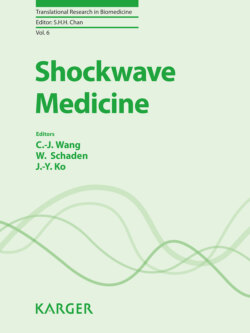Читать книгу Shockwave Medicine - Группа авторов - Страница 14
На сайте Литреса книга снята с продажи.
SWT Stimulodynamics: Mechanisms of Action and Biological Responses
ОглавлениеPathophysiologies especially in chronic states are multifactorial and are often indocile to most treatments and remain an enigma for clinicians to ameliorate. Dissimilar from its use for the eradication of urolithiasis at its inception, the utility of medical shockwave treatment (SWT) today is considered for its regenerative properties to address impervious conditions encountered by various medical disciplines as mentioned earlier in the chapter. Stimulodynamics may be considered as the action or influence exacted by a particular force on tissue, and the ensuing biochemical and biocellular responses derived from it. Although the exact mechanisms of action (stimulokinetics) of SWs on tissue is yet to be completely elucidated (as is the case for most if not all medical interventions), researchers (i.e., Schaden et al. [13], Ogden et al. [26], Wang [28], Notanicola and Moretti [35], Mittermayr et al. [51], among others) have provided insights into the biological responses associated with SWT and the regenerative outcomes observed in non-union fractures, tendinopathies, and chronic wounds [13, 21, 26, 35, 51]. More recently, ground-breaking investigations by Lobenwein et al. [69], Sukubo et al. [89], and Holfeld et al. [90] have provided greater elucidation into the possible mechanics of action of SWT on tissue. These investigations revealed that a dose-dependent signal transduction from SWT influenced toll-like receptors, macrophages, and interleukins leading to a cascade of biochemical and biocellular responses commencing with angiogenesis [65, 69, 87–90], which then translates into a combination of regenerative processes leading toward homeostatic return and function. The culminating biochemical and biocellular responses influenced by SWT are seen to effectively address multiple aberrances associated with complexities, which include modulation of neurotransmitters (i.e., Substance P Calcitonin Gene-Related Peptide), and inflammatory factors (i.e., prostaglandin, interleukins), encouraging analgesia and pain modulation in chronic and even complex pain conditions [41, 91–93, 131]; Progenitor cell, mescenchymal stem cell, and growth factor proliferation (i.e., vascular endothelial growth factor, transforming growth factor β-1) [28, 35, 94–99] are all elements seen to assist with progenesis responses such as angiogenesis [49–70, 88–90, 97–99], osteogenesis [8, 12–22, 100–103], and tendogenesis [28–45, 94, 95].
